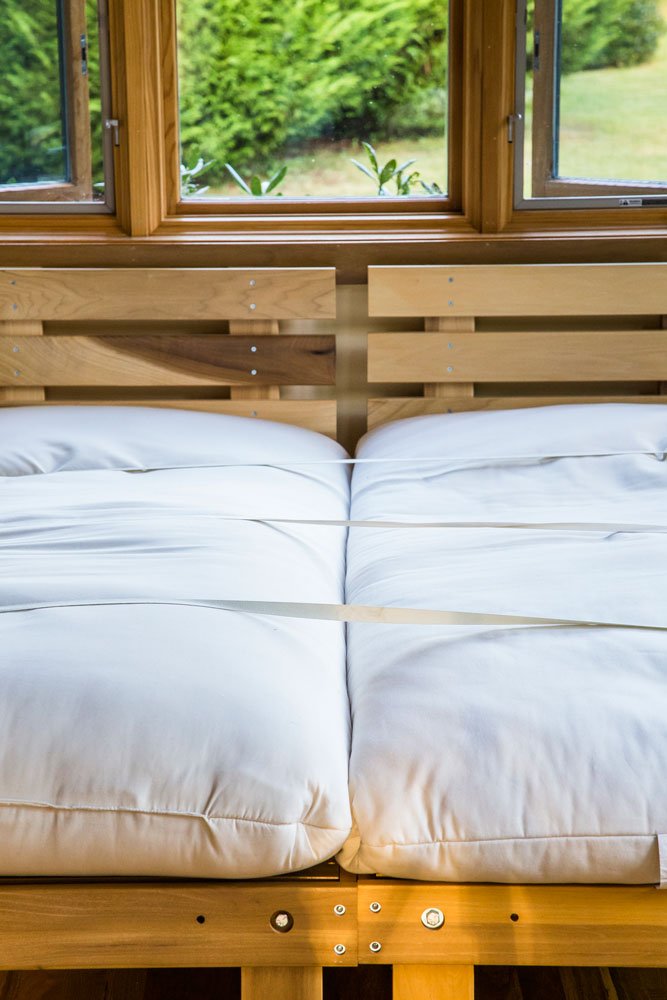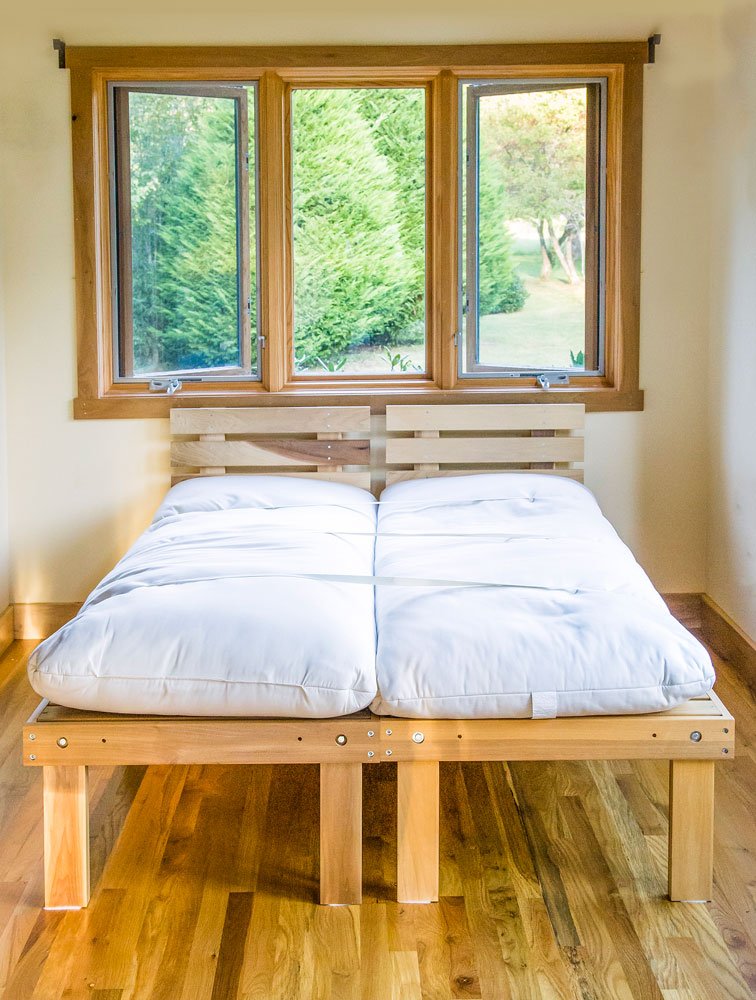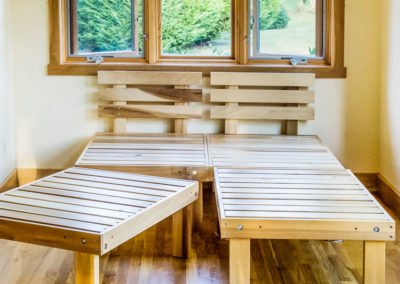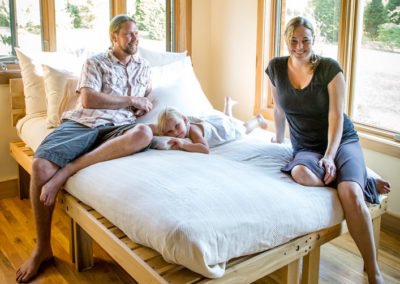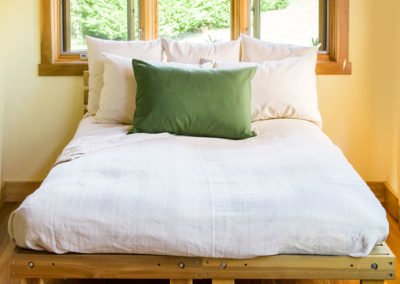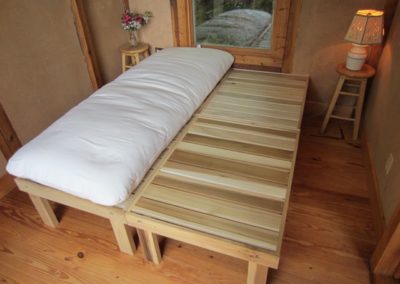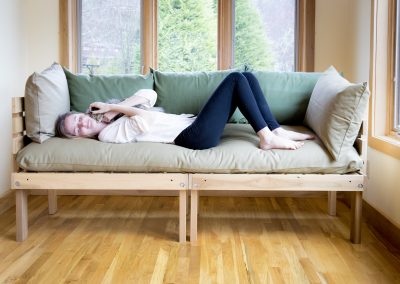Why You Will Love It!
- Our Futon provides the perfect balance of support and padding
- Wool is a natural relaxer and relieves stress and tension allowing your body to peacefully enter sleep
- Kapok is hypo-allergenic and naturally resistant to dust mites, mold and mildew
- Provides ultimate ventilation and temperature regulation – far beyond that of cotton batting or latex
- Compact, sleek, minimalist design
- An affordable and comfortable answer to an organic bed
How You Can Use It
- Our futon is refreshingly modular
- You can build a standard queen size bed with 4 Eco Squares, or use the 1/2 queen size (European Single) with only 2 Eco Squares.
- If your needs change in the future you can use the Futon as a bed or couch
- Moving is a breeze since you can fold up the Futon and put it in the back of your car
- Kapok is easy to re fluff to keep the surface evenly distributed
- Kapok loves to be freshened in the sun to keep it fluffy and light
- Can be used on the floor or with our sleek EcoSquare™ Frame
- Each EcoSquare is 30″ x 40″ x 16″
What It's Made Of
- Futon: Organic Cotton Canvas
- Inside Layer: Eco Wool Felt Barrier Cloth
- Inside Stuffing: Eco-friendly Kapok Fiber
- At first futon will be very thick and soft. Usually within a week or two of use it will settle to about four inches thick
- Wool barrier wicks moisture and makes Futon fire resistant
- Wool barrier adds a supportive and springy resilient layer on the surface.
What Our Customers Are Saying
I had been plagued for many years with constant low-back pain. I take care of myself and try to stay healthy, so this constant pain was getting in my way. Every now and again, I woud even get sciatica pains to add to it. It came time to get a new mattress, and I decided to do some research. I was thinking about a futon…and I started reading about Japanese-style. Long story short, I decided to get one from Carolina Morning, and I am so glad that I did! It has been the most comfortable sleep I have ever had. I no longer have chronic low-back pain…and that is just from changing over to sleeping in this mat on the floor! I have not been to a chiropractor or anyone else, the result came strictly from sleeping on this futon. I have been telling people about it ever since! Thank you!
Your products made it possible for my wife and I to move to a small apartment in style. Never slept so good in years–even on an expensive bed. You have obviously put much talent and time into developing deceptively siimple concepts that allowed us to walk in and buy off the shelf all that we needed to downscale, simplify, and green our abode. Moving was a breeze! Thank you so much!
I love that I can fluff / resdistribute the kapok as needed. I could never do that when my last mattress started to dip. My husband had been sleeping on the floor for a year before we bought the futons. We are now, happily sleeping together.
Frequently Asked Questions
Can I place the futon on the floor?
“On the floor” meaning, at least raised up an inch or so, yes.
But do not place this or any other futon directly on floor, as condensation and mold may result due to the natural persperation of the body during sleep. We highly recommend at least a tatami mat and/or blanket underneath.
Optimal surface to place the futon: slatted platform bedframe such as our EcoSquare™
What is the firmness level?
Provides a firm but bouyant consistency. The ultimate sleeping surface–combining the best qualities of each material for a synergy no other bed can offer.
This bed was designed after a decade of ground-breaking research and development which is published in our online article at here.Sweet Dreams on a Hard Surface
What is your refund policy?
Due to Federal Health and Safety Regulations, bedding products
including futons, pillows and blankets are not returnable.
Does it contain any treatments or anything toxic and unnatural?
Absolutely not! We use only organic and chemical free ingredients, Wool Felt Barrier Cloth is Eco Wool is domestically produced and is not certified organic but is essentially organic from Woolgatherers Carding Mill in Montague, CA. One of the three only organic wool mills left in the US. Kapok is from Malasia and is third party tested to be free of any detectable chemical residues. Cover is certified organic cotton canvas.
How long does it take the futon to break in to it's designated thickness?
When your futon first arrives it will be very thick and soft–about 8 inches thick. Usually within a about a month with everyday use, depending on the weight of the people sleeping on it, it will settle down to about four inches thick.
Fluffing
At first you will need to fluff the futon each day or night to even out the thickness.
You do this by patting the futon surface from the top to the middle and from the bottom to the middle with the palms or sides of your hands. This takes about 20 seconds to a minute. Some people don’t fluff at all. Some people fluff every day, some every few days. It’s a matter of personal preference.
Will I feel the crack in the middle?
You won’t perceive the crack between the two futons if the bed is prepared properly as follows:
Use the unity straps that come with the futon to hold them together. (Shown in illustration and video.)
Also place some kind of mattress pad over the entire top. The simplest thing is a blanket. We carry one which works perfectly for this purpose. The Organic Cotton Yoga Blanket.
Can I put the futon away during the day?
Our organic futon can be folded in half and put in a corner or closet during the day to increase the useable space in your house. Folded dimensions are 30″ x 40″ x 12″ .
What are the dangers of non-organic bedding?
Modern Bedding: A Toxic Nightmare
Flame retardant chemicals are in almost everything: Not only in our TV’s, clothing, furniture, carpets and electronic equipment; they are also in our air, water, food and our own bodies. Their levels are especially high in our babies and children, because children eat, drink and breathe more than adults. These chemicals disrupt our thyroid function, immune systems, brain development and can possibly cause cancers. Human blood and tissue levels of these toxins have been doubling every two and a half years in the USA.
What are these chemicals and what can you do to protect yourself and your family from their effects?The manufacturers aren’t required to put the fire retardant chemicals on the label. The most commonly used chemicals, and their health hazards are:
* Boric acid – Inhaling the dust can cause headaches, coughing, dizziness or difficulty breathing. Prolong contact may cause skin sensitization.
* PBDE’s – are prohibited in the European Union after high levels were found in breast milk. California has decided to phase out the use of two of these, penta and octa PBDE by 2008. PBDEs accumulate in the body tissues and cause thyroid hormone disruption, permanent learning and memory impairment, decreased sperm count, fetal malformations, behavioral changes, hearing deficiencies and possibly cancer. U.S. women have levels in their body tissues 50 times more than European women. (For more eye-opening information, click on the link at the end of this report to “Our Stolen Future” Website containing results of a study of PBDEs).
* Formaldehyde – the U.S. Consumer Product and Safety Commission states in a report on urethane insulation, “Many health complaints, including irritation of the eyes, nose, throat, and skin, headaches and shortness of breath, have been reported to CPSC over the last several years by consumers who have had UFFI in their homes. Less frequently reported symptoms include chest pain, diarrhea, nausea, fatigue, and sleep disturbance. Studies have shown that formaldehyde in liquid solution (and possibly formaldehyde gas) can, through repeated exposure, cause sensitization in certain individuals. When exposed to formaldehyde gas, sensitized individuals may exhibit allergic dermatitis or mild-to-severe asthmatic reactions.” This was talking about formaldehyde outgassing from insulation. The same effects would occur from exposure to formaldehyde outgassing while you are sleeping in your bed. CPSC considers formaldehyde to be a potential human carcinogen.
* Decabromodipheyl Oxide – is a developmental toxicant. Exposing mothers to it during pregnancy can cause the death of or disrupt the development of the fetus. It causes birth defects and low birth weight. Behavioral or psychological problems can appear as the child grows.
* Melamine – is a reproductive toxicant, which can cause premature menopause, decreases in male and female fertility, onset of puberty, and changes in menstruation, gestation time, and lactation. It is a development toxicant with all of the hazards of Decabromodiphyl Oxide mentioned above. It is a cardiovascular and blood toxicant. This affects the ability of red blood cells to carry oxygen, white blood cells to fight disease, abnormal heartbeat, decreased blood flow, and elevated blood pressure.
* Antimony – The Australian Government Department of Environment and Heritage says of antimony,” Antimony compounds show toxic properties similar to those of arsenic. This depends on how much antimony a person has been exposed to, for how long, and current state of health. Exposure to high levels of antimony can result in a variety of adverse health effects. Breathing high levels for a long time can irritate eyes and lungs and can cause heart and lung problems, stomach pain, diarrhea, vomiting, and stomach ulcers. Ingesting large doses of antimony can cause vomiting. When eaten by mold or mildew, antimony releases a poisonous gas called stibine. This gas has caused epidemics of deaths in the past.
These are a few of the chemicals used as fire retardants. Polyols, toluene diisocyante, amines, siloxanes, styrene, limonene, benzene and many others are also used. If you find any chemicals listed on your mattress label, you can search the web for more information. Write the chemical in the search box adding a comma, then write “health hazard.” But you can’t trust the label, because by law therre is no requirement to list any or all of the ingredients.
Click here for more information on the chemical hazards of modern mattresses.
This is a very well done presentation and easy to watch
http://www.slideshare.net/metametrix/environmental-toxicity-and-the-effect-on-health
How does this futon compare to a traditional Japanese futon?
Our futon is thicker than the traditional Japanese futons. However it is not a lot thicker and is much closer to it than the other futons on the American market today. For something closer to the traditional Japanese futon, see our Paleo Pad™.
Here is an excerpt from www.aboutjapan.com
Although many Japanese sleep in beds in these days, it is still common to sleep on a futon mattress spread on the floor. Westerners call the small couch which turns into a bed a futon, but that is very different from the traditional Japanese futon. A traditional Japanese futon set includes shikibuton (under futon), kakebuton (comforters), and makura (pillow).
Shikibuton is usually stuffed with cotton batting and is wrapped in shikifu (sheets). Japanese uses different types of futon, depending on the season, such as light ones in summer and heavy ones in winter. Futon made from down feathers is light and comfortable but is most expensive. Kakebuton is covered by kakebuton cover. The traditional Japanese pillow (makura) is filled with red beans or buckwheat chaff.
Futon is usually put away during the day in the closet called oshiire. The oshiire closet has sliding doors and usually divided into two shelves. It is best to keep the futon on the upper shelf. Japanese houses are usually small and do not have many rooms, so a room is used for dual purposes. During the day, a room can be used as workroom or guest-room after futon is stored in the oshiire. It is very convenient.
It is important to sometimes dry futon under direct sunshine. You may ruin your futon if you keep them in the closet or spread on the floor all the time. Remember that Japan is very humid especially in rainy season. There is a product called futon kansouki (futon dryer) in Japan. Just place the dryer between kakebuton and shikibuton while it is spread on the floor. Airing your futon really helps you sleep well.
Also, it is commonly said that sleeping on futon is better for the back than sleeping on a soft bed. The hardness of the floor seems to be good for people who have back problems.
What is breathablity and how does it effect my sleep?
(The ability to allow air to circulate, transport moisture, and stay dry.)
Naturally people create a warm, humid sleep environment each night by climbing into bed and falling asleep. That’s because we generate body heat and perspiration. In fact, we all perspire (and respire) about a cup each night. Our mattress is exposed to this heat and moisture. It must manage these conditions efficiently to provide comfortable, restorative sleep and mattress longevity. When moisture in a mattress is trapped and allowed to build up, our body temperature rises, we continue to sweat, our heart rate and blood pressure rise, our breathing is irregular, and we often wake up. Our sleep is disturbed. We’re uncomfortable. And rather than being refreshed and restored, our sleep has given our body a workout.
Trapped moisture also facilitates the growth of natural allergens such as molds, mildew, and dust mites. A mattress construction that promotes air flow and allows perspiration to evaporate helps our bodies cool themselves effectively and maintain a comfortable body temperature.
And because the mattress is drier, the presence of allergens is reduced, which has a positive impact on nighttime breathing. A breathable mattress does more than create a healthy, comfortable sleep environment. It also helps mitigate wear due to heat and moisture, both of which lead to material degradation and premature wear. Many conventional mattresses are topped with polyester and polyurethane foam or memory foam, which are especially vulnerable to environmental stress. Under the weight, heat, and humidity of your body, this non-breathable fabric and cushioning all too often compress prematurely creating uncomfortable, unsupportive body imprints and sag.
How is the Futon different from the Paleo Pad?
About Your Organic Kapok/Wool Futon
Construction
1. The cotton canvas fabric on the outside is certified organic and is milled in South Carolina.
2. The second layer is a 3/8-inch wool batting that is also certified organic. For more information about Eco-wool, see http://www.thewoolgatherer.com/products.php
3. The futon is filled with 25 pounds of kapok, which is a feather-like plant fiber from tropical trees that grow without pesticides or fertilizer.
Care and Maintenance
On a Frame: The best placement of the futon is on a frame with slats that are about 1 inch apart. This allows air to circulate through the futon, which is
healthier for you and for the futon itself. We offer a unique, modular set of frames. Two Eco Squares hold a half-queen futon, and four Eco Squares fit two half-queens.
On the Floor: As with any mattress, if you place it on the floor, you will need to turn it frequently – perhaps when you change the bedding—so that the same side isn’t always on the floor. Otherwise perspiration from the body will condense underneath the futon and mildew may result. You will also want to air the futon in the sun at least several times a year. You can use a natural, woven rug such as tatami or a jute mat underneath to provide a bit of a barrier, but you will still want to turn the futon frequently. The outer fabric can be spot cleaned, but avoid soaking the fabric. If the wool or kapok become wet, it will be difficult to dry them. You can use a hair dryer to dry spots that get too wet. But it is best to minimize the amount of water used.
Breaking in Period
Your futon will be quite “fluffed up” when it arrives. Once it is in place, spend a few minutes patting and smoothing the kapok to evenly distribute it within the covering. For the first few weeks, your sleeping body will leave an imprint, as the kapok has not yet compacted to the futon’s finished height of 4 inches. Since you don’t want that imprint to be permanent, continue to smooth and redistribute the kapok each morning for 2 to 4 weeks. With this initial care, the futon will settle to provide the firm but resilient sleeping surface for which it is known. All mattresses become compressed over time, but unlike foam or cotton, kapok can be fluffed and redistributed indefinitely. If you continue to pat the futon surface from the top and bottom toward the middle every few days, you will find the same resilient surface each night.
How to Make a Queen Bed
When you order two futons for a queen bed, we provide a set of Unity Straps to help unite the two. Once joined, covering the two with a good quality, queen-sized mattress pad will help to eliminate the slight dent formed where they join. Some people simply use a blanket underneath the bottom sheet rather than a mattress pad. Any blanket will do, but we keep in stock a queensized, organic cotton blanket that is the right size for that purpose.
